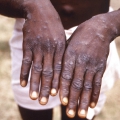|
23 05.2022
Monkeypox virus is mainly transmitted to humans from wild animals such as rodents and primates. Its secondary distribution by human-to-human transmission is limited.
|
Key Facts
Monkeypox virus is mainly transmitted to humans from wild animals such as rodents and primates. Its secondary distribution by human-to-human transmission is limited.
Monkeypox is a rare viral zoonotic disease that occurs mainly in remote areas of Central and West Africa, located near tropical rainforests.
There is no specific treatment or vaccine for monkeypox, but prior vaccination against smallpox also provides highly effective prevention of monkeypox.
Monkeypox virus belongs to the genus Orthopoxvirus in the Poxviridae family.
Monkeypox is a rare viral zoonotic disease (i.e., a disease transmitted to humans from animals) whose symptoms in humans are similar to those seen in the past in patients with smallpox, but less severe. After the eradication of smallpox in 1980 and the subsequent cessation of the use of variola vaccines, monkeypox became the most pathogenic to humans among other orthopoxviruses. Cases of monkeypox still occur sporadically in parts of Africa dominated by tropical rainforests.
Disease outbreaks
Monkeypox in humans was first identified in 1970 in the Democratic Republic of the Congo (then known as Zaire) in a 9-year-old boy in an area where smallpox was eradicated in 1968. Since then, most cases have been reported in rural areas of the tropical rainforests of the Congo Basin and West Africa, especially in the Democratic Republic of the Congo, where the disease is considered endemic. In 1996-1997 in the Democratic Republic of the Congo, there was a major outbreak of the disease.
In the spring of 2003, confirmed cases of monkeypox were reported in the Midwestern region of the United States of America. This was the first reported case of the disease outside the African continent. It was found that most of the cases had contact with domesticated prairie dogs that were infected with rodents imported from Africa.
Sporadic cases of monkeypox have been reported in many countries in western and central Africa, and as awareness of the disease grows, so does the number of cases being diagnosed. Since 1970, cases of human infection with monkeypox have been reported in 10 African countries: the Democratic Republic of the Congo, the Republic of the Congo, Cameroon, the Central African Republic, Nigeria, Côte d'Ivoire, Liberia, Sierra Leone, Gabon and South Sudan. In 2017, Nigeria experienced the last outbreak known to date, the first case in that country in 40 years.
Transmission
Infection in index cases occurs as a result of direct contact with the blood, body fluids, and affected skin or mucous membranes of infected animals. In Africa, human infections have been documented from handling infected monkeys, Gambian rats and squirrels, with rodents being the likely reservoir of the virus. One possible risk factor is eating the meat of infected animals without proper heat treatment.
Secondary or person-to-person transmission occurs through close contact with infected respiratory secretions, skin lesions of an infected person, or objects contaminated with body fluids or materials from lesions of a sick person.
Transmission of the infection occurs predominantly by airborne droplets with prolonged personal contact, which puts the family members of a person with an acute case of the disease at the greatest risk of infection. Transmission can also occur by inoculation or through the placenta (congenital monkeypox). To date, there is no evidence that human-to-human transmission alone is sufficient to maintain monkeypox infection in the human population.
Recent animal studies using the prairie dog and human monkeypox models have identified two distinct monophyletic groups of the virus, from the Congo Basin and West Africa, with the former group found to be more virulent.
Signs and symptoms
The incubation period (time from infection to onset of symptoms) of monkeypox is typically 6 to 16 days, but can range from 5 to 21 days.
The infection can be divided into two periods:
period of invasion (0-5 days), which is characterized by fever, severe headache, lymphadenopathy (swollen lymph nodes), back pain, myalgia (muscle pain) and severe asthenia (weakness);
a period of rashes on the skin (1-3 days after the onset of fever), when various stages of rash appear, often first appearing on the face and then spreading to other parts of the body. Most often they appear on the face (in 95% of cases), as well as on the palms and feet (in 75% of cases). Rashes go through several stages of development - from maculopapules (skin lesions with a flat base) to vesicles (small fluid-filled blisters) and pustules, which crust over after about 10 days. It may take up to three weeks for the crusts to completely disappear.
The number of skin lesions varies from a small number to several thousand. They appear on the membranes of the mucous membranes of the oral cavity (in 70% of cases), the genitals (30%), as well as on the conjunctiva (eyelid) (20%) and the cornea (eyeball).
Some patients develop severe lymphadenopathy (swollen lymph nodes) before the rash appears, which is a hallmark of monkeypox compared to other similar diseases.
Monkeypox is usually a self-limiting disease, with symptoms lasting 14 to 21 days. Severe cases most commonly occur in children and are related to the degree of exposure to the virus, the health of the patient, and the severity of complications.
People living in or near forested areas may be indirectly or mildly exposed to infected animals, which may result in subclinical (asymptomatic) infection.
Mortality varies widely between epidemics, but has been less than 10% in documented cases. Most deaths occur among young children. In general, younger age groups may be more susceptible to monkeypox disease.
Diagnostics
The clinical differential diagnosis should consider the possibility of other rash-related diseases such as smallpox (even though the disease has been completely eradicated), chickenpox, measles, bacterial skin infections, scabies, syphilis, and drug allergies. Lymphadenopathy in the prodromal stage of the disease may serve as a clinical feature that distinguishes monkeypox from smallpox.
The final diagnosis can only be made based on the results of laboratory diagnostics in specialized institutions, where this requires a number of specific tests to detect the virus. When monkeypox is suspected, health care workers should properly sample the patient (see below) and transport the samples under proper conditions to a laboratory with diagnostic capabilities.
It is best to take samples of the affected areas of the body - smears of exudate or crust. They should be stored in dry, sterile tubes (not in a special medium for transporting viral materials) placed in a refrigerator. Blood or serum samples can be used, but their analysis often does not provide a definitive conclusion due to the short duration of viremia and the suboptimal timing of sampling.
For the interpretation of the result, it is very important that information about the patient is provided with the sample, including:
a) the approximate date on which the temperature rose;
b) date of onset of rash;
c) date of sampling;
d) current stage of the disease (stage of development of the rash);
e) the age of the patient.
Treatment and vaccine
There is no specific treatment or vaccine for monkeypox, but outbreaks of the disease are manageable. Smallpox vaccination has been 85% effective in preventing monkeypox in the past, but since the worldwide eradication of smallpox, this vaccine is no longer available to the general population. However, having been vaccinated against smallpox in the past may contribute to a less severe course of the disease.
Natural carriers of the monkeypox virus
In Africa, monkeypox infection has been found in many animal species, such as striped squirrels, tree squirrels, gambian rats, striped mice, selevinia, and primates. The natural history of the virus remains unclear, and further research is needed to determine the exact reservoir of the monkeypox virus and how it is sustained in nature.
In the US, the virus is believed to have been transmitted from African animals to some sensitive non-African animal species (such as the prairie dog) as a result of these animals living in the common area.
Prevention
Reducing the risk of infection in humans
During outbreaks of monkeypox, close contact with other patients is the most significant risk factor for infection with monkeypox virus. In the absence of specific treatment and a vaccine, the only way to reduce human infections is to raise awareness of risk factors and educate the public about measures that can be taken to limit exposure to the virus. Surveillance measures and the rapid detection of new cases are essential to control outbreaks.
When conducting health education among the population, special attention should be paid to the following risk factors:
Reducing the risk of animal-to-human transmission. Efforts to prevent transmission in endemic areas should be directed, firstly, to the exclusion of any contact with rodents and primates, and secondly, to limit direct contact with blood and meat, including the need for thorough heat treatment of animal products before consumption. food. Gloves and other appropriate protective clothing must be worn when handling sick animals or their infected tissues, and when animals are slaughtered.
Reducing the risk of human-to-human transmission. Close physical contact with people infected with monkeypox should be avoided. When caring for sick people, wear gloves and use protective equipment. Hands should be washed regularly after caring for or visiting sick people. Patients are recommended to be isolated either at home or in a medical institution.
Infection control in healthcare settings
Health care workers caring for patients with suspected or confirmed monkeypox virus infection, or handling specimens from such patients, should take standard infection control precautions.
Health care workers and people who come into contact with monkeypox patients or specimens taken from them should contact their national health authorities to consider vaccinating them against smallpox. However, people with weakened immune systems should not be vaccinated against smallpox using older vaccines.
Specimens taken from humans and animals suspected of being infected with monkeypox virus should be handled by specially trained staff in suitably equipped laboratories. When transporting specimens taken from patients, they should be placed in a safe container and follow the rules for handling infectious substances.
Prevent further spread of monkeypox through the animal trade
Restricting or banning the movement of small African mammals or monkeys can be effective in curbing the spread of the virus outside of Africa.
Captive animals should not be vaccinated against smallpox. However, potentially infected animals must be isolated from other animals and immediately placed under quarantine. Any animals that may have come into contact with an infected animal must be quarantined and monitored for symptoms of monkeypox for 30 days.*
*Published based on WHO materials







